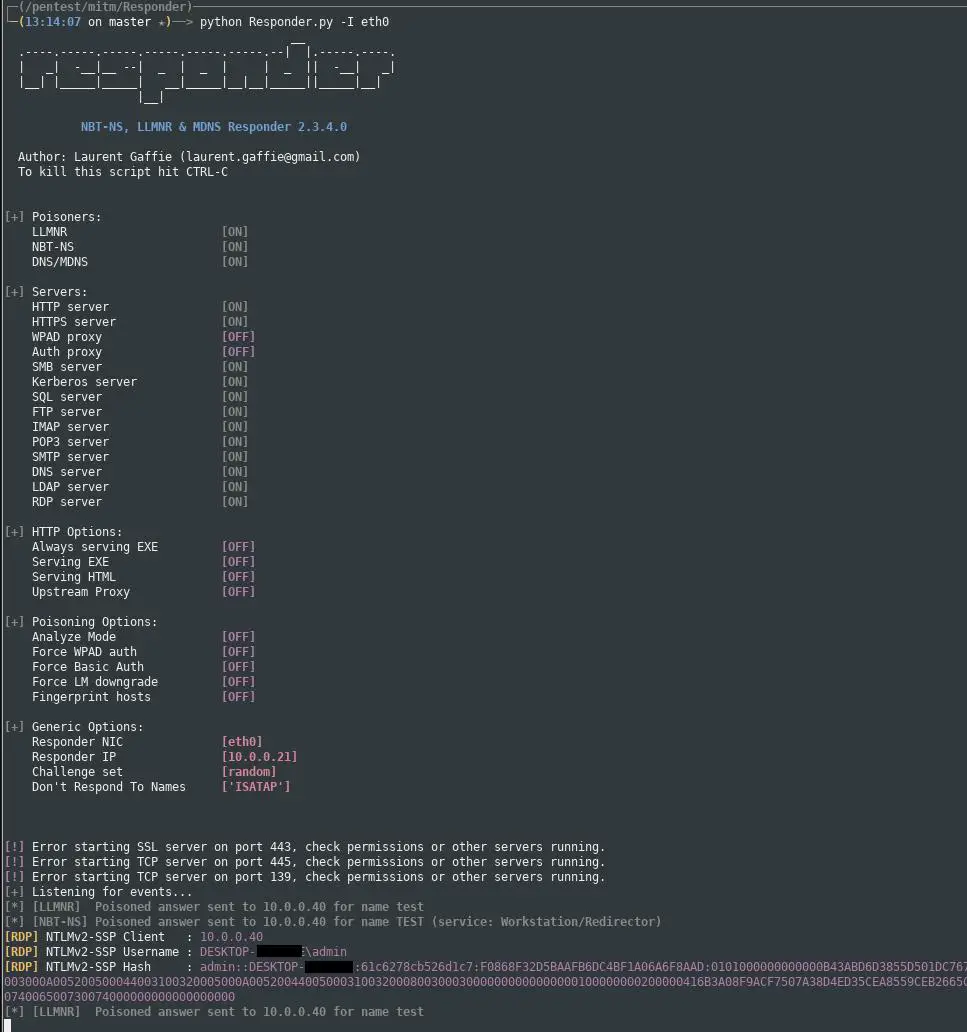Responder v3.1.4 releases: LLMNR/NBT-NS/mDNS Poisoner and NTLMv1/2 Relay

Responder an LLMNR, NBT-NS, and MDNS poisoner. It will answer to specific NBT-NS (NetBIOS Name Service) queries based on their name suffix (see: http://support.microsoft.com/kb/163409). By default, the tool will only answer to File Server Service request, which is for SMB.
The concept behind this is to target our answers and be stealthier on the network. This also helps to ensure that we don’t break legitimate NBT-NS behavior. You can set the -r option via command line if you want to answer the Workstation Service request name suffix.
Features
- Built-in SMB Auth server.
Supports NTLMv1, NTLMv2 hashes with Extended Security NTLMSSP by default. Successfully tested on Windows 95 to Server 2012 RC, Samba, and Mac OSX Lion. Clear text password is supported for NT4 and LM hashing downgrade when the –lm option is set. SMBv2 has also been implemented and is supported by default.
- Built-in MSSQL Auth server.
In order to redirect SQL Authentication to this tool, you will need to set the option -r (NBT-NS queries for SQL Server lookup are using the Workstation Service name suffix) for systems older than Windows Vista (LLMNR will be used for Vista and higher). This server supports NTLMv1, LMv2 hashes. This functionality was successfully tested on Windows SQL Server 2005 & 2008.
- Built-in HTTP Auth server.
In order to redirect HTTP Authentication to this tool, you will need to set the option -r for Windows version older than Vista (NBT-NS queries for HTTP server lookup are sent using the Workstation Service name suffix). For Vista and higher, LLMNR will be used. This server supports NTLMv1, NTLMv2 hashes and Basic Authentication. This server was successfully tested on IE 6 to IE 10, Firefox, Chrome, Safari.
Note: This module also works for WebDav NTLM authentication issued from Windows WebDav clients (WebClient). You can now send your custom files to a victim.
- Built-in HTTPS Auth server.
Same as above. The folder certs/ contains 2 default keys, including a dummy private key. This is intentional, the purpose is to have Responder working out of the box. A script was added in case you need to generate your own self-signed key pair.
- Built-in LDAP Auth server.
In order to redirect LDAP Authentication to this tool, you will need to set the option -r for Windows version older than Vista (NBT-NS queries for HTTP server lookup are sent using the Workstation Service name suffix). For Vista and higher, LLMNR will be used. This server supports NTLMSSP hashes and Simple Authentication (clear text authentication). This server was successfully tested on Windows Support tool “LDP” and LdapAdmin.
- Built-in FTP, POP3, IMAP, SMTP Auth servers.
This module will collect clear text credentials.
- Built-in DNS server.
This server will answer type A queries. This is really handy when it’s combined with ARP spoofing.
- Built-in WPAD Proxy Server.
This module will capture all HTTP requests from anyone launching Internet Explorer on the network if they have “Auto-detect settings” enabled. This module is highly effective. You can configure your custom PAC script in Responder.conf and inject HTML into the server’s responses. See Responder.conf.
- Browser Listener
This module allows finding the PDC in stealth mode.
- Fingerprinting
When the option -f is used, Responder will fingerprint every host who issued an LLMNR/NBT-NS query. All capture modules still work while in fingerprint mode.
- Icmp Redirectpython tools/Icmp-Redirect.py
For MITM on Windows XP/2003 and earlier Domain members. This attack combined with the DNS module is pretty effective.
- Rogue DHCPpython tools/DHCP.py
DHCP Inform Spoofing. Allows you to let the real DHCP Server issue IP addresses, and then send a DHCP Inform answer to set your IP address as a primary DNS server, and your own WPAD URL.
- Analyze mode.
This module allows you to see NBT-NS, BROWSER, LLMNR, DNS requests on the network without poisoning any responses. Also, you can map domains, MSSQL servers, workstations passively, see if ICMP Redirects attacks are plausible on your subnet.
Install
git clone https://github.com/lgandx/Responder.git
Usage
First of all, please take a look at Responder.conf and tweak it for your needs.
Running the tool:
./Responder.py [options]
Typical Usage Example:
./Responder.py -I eth0 -rPv
Options:
NBT-NS/LLMNR Responder
Responder, a network take-over set of tools created and maintained by Laurent Gaffie.
email: laurent.gaffie@gmail.com
Source: https://github.com/lgandx/






